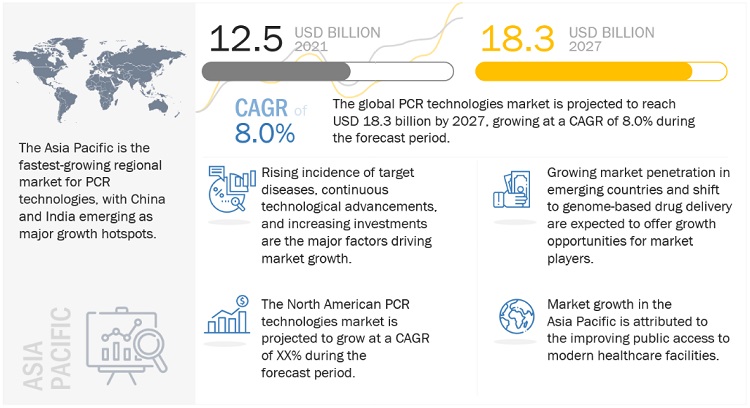Polymerase Chain Reaction (PCR) technology has revolutionized molecular biology and diagnostics since its inception in the 1980s. Over the years, PCR techniques have evolved significantly, leading to the emergence of several distinct methods catering to various applications in research, diagnostics, forensics, and more. This article delves into the PCR technologies market, segmented by three key techniques: Conventional PCR, Quantitative PCR (qPCR), and Digital PCR (dPCR).
PCR Technologies Market by Technique (Conventional, qPCR, dPCR) – Global Forecast to 2027
The global market is projected to reach USD 18.3 billion by 2027 from USD 12.5 billion in 2021, at a CAGR of 8.0%
Download a PDF Brochure: https://www.marketsandmarkets.com/pdfdownloadNew.asp?id=96291811
1. Conventional PCR
Conventional PCR, the foundation of modern PCR technology, remains a cornerstone in molecular biology laboratories worldwide. This technique involves cycles of denaturation, annealing, and extension of DNA sequences using heat-stable DNA polymerase enzymes, such as Taq polymerase. Initially developed by Kary Mullis in 1983, conventional PCR paved the way for numerous scientific advancements by enabling amplification of specific DNA sequences from minimal starting material.
Market Dynamics:
- Current Landscape: Despite the emergence of newer PCR techniques, conventional PCR continues to be widely used due to its simplicity, cost-effectiveness, and versatility.
- Applications: It is instrumental in gene cloning, genotyping, pathogen detection, and DNA sequencing preparation.
- Market Growth: While growth in this segment may not be as rapid as newer technologies, steady demand persists, driven by research institutions, academic laboratories, and smaller diagnostic facilities.
2. Quantitative PCR (qPCR)
Quantitative PCR, also known as real-time PCR, represents a significant advancement over conventional PCR by enabling real-time monitoring and quantification of DNA amplification. This technique uses fluorescent dyes or probes to measure amplification as it occurs, providing insights into initial template quantity and enabling precise quantification of target DNA or RNA molecules.
Market Dynamics:
- Advantages: Offers high sensitivity, specificity, and the ability to quantify nucleic acids accurately.
- Applications: Widely used in gene expression analysis, viral load quantification, genetic testing, and biomarker analysis.
- Market Growth: The qPCR market has seen substantial growth fueled by demand from clinical diagnostics, pharmaceutical research, and biotechnology sectors due to its crucial role in disease diagnosis and monitoring.
3. Digital PCR (dPCR)
Digital PCR represents a recent innovation that partitions a sample into thousands of individual reactions, allowing absolute quantification of nucleic acids without the need for standard curves. This technique provides higher precision and sensitivity compared to qPCR by counting individual DNA or RNA molecules present in a sample.
Market Dynamics:
- Precision and Sensitivity: Offers improved accuracy for low-abundance targets and detection of rare mutations.
- Applications: Particularly valuable in oncology (for liquid biopsies), environmental testing, and detection of genetically modified organisms (GMOs).
- Market Growth: While currently a smaller segment compared to qPCR, dPCR is experiencing rapid adoption, driven by advances in technology, decreasing costs, and increasing awareness of its benefits in critical applications.
Market Trends and Future Outlook
The PCR technologies market is poised for continued growth and innovation, driven by technological advancements, increasing research and development activities, and expanding applications across various sectors including healthcare, agriculture, and environmental monitoring. Key trends shaping the market include:
- Automation and Integration: Growing demand for automated PCR systems that streamline workflows and reduce hands-on time.
- Point-of-Care Testing (POCT): Increasing adoption of PCR technologies for decentralized testing, especially in clinical settings where rapid and accurate diagnosis is critical.
- Emerging Markets: Rapid expansion in developing regions, driven by increased healthcare spending, infrastructure development, and rising awareness of molecular diagnostics.
- Technological Innovations: Continued development of novel PCR chemistries, digital platforms, and multiplexing capabilities to enhance sensitivity, specificity, and throughput.
- Regulatory Landscape: Evolving regulatory frameworks influencing market dynamics, particularly in clinical diagnostics and biopharmaceutical applications.
Conclusion
The PCR technologies market, segmented by conventional PCR, qPCR, and dPCR techniques, reflects a dynamic landscape characterized by continuous innovation and diverse applications. While conventional PCR remains foundational, qPCR and dPCR have emerged as indispensable tools in molecular biology, clinical diagnostics, and beyond. As technology evolves and market demands grow, stakeholders in the PCR technologies sector can expect further advancements, driving enhanced capabilities and broader adoption across global markets.

Leave a comment